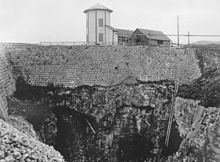 | ||
Rällingsberg mining area (Swedish: Rällingsbergs gruvor) is an area with four defunct iron mines outside the location Långshyttan, Husby parish, Hedemora Municipality, Dalarna County, Sweden. The mining area is now part of the ecomuseum Husbyringen.
History
The mining field was discovered in 1841 by farmworker Clas Westerholm. With a borrowed mining compass he found a wide-spread magnetic field east of lake Rällingen near a pice of farmland called Gruvvreten (swedish for mining field). He got his claim registered January 30, 1841 and became half-owner of the prospect together with the owner of Klosters bruk. In June the same year a contract was made on mining in what was to become Rällingsbergsgruvan. After six years Westerholm was bought out of the mine for 8 000 kronor, but about 35 years later a second payment was made of the sum 5 000 kronor, since he had spent all his money and was dirt poor. In 1871 the owners of the ironworks started a stock company Klosters AB and in 1892 Rällingsbergs gruvaktiebolag was formed as a daughter company.
The ore in the mine had a high quantity of manganese and was suitable for bessemer iron that was produced in the new blast furnace in Klosterverken (järnbruket in Långshyttan) from 1861 (with an interruption 1864–1868). To have access to its own ore reduced the cost of the company at Kloster consideably, partly compensating for the lack of own charcoal.
The mines were run until 1932.
